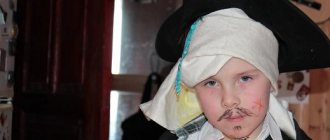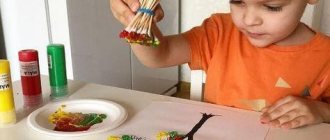Content and features of subject-related activities of early age
Definition 1
Subject activity is one of the ways to teach a young child those skills and actions with various objects that are enshrined in the unspoken rules of society.
Through object-based activity, the child develops skills in working with a variety of objects, mental processes develop, thinking, consciousness, and speech apparatus are formed. Such activity involves the development of skills in using objects, based on their functional purpose and the socially accepted procedure for its use in practical life.
Active activity plays an important role at any stage of personality development. From an early age, individual experience is formed and abilities for elementary types of children's activities develop. it has a huge impact on the development of a child’s intelligence. This occurs due to the fact that when interacting with objects, he learns to determine and distinguish their parameters and features, spatial position, and identifies their functional role. In this way, the volitional qualities of the individual are formed, or rather, the foundation is laid for their subsequent development. The child learns responsibility, strives to complete an action and get a certain result.
Are you an expert in this subject area? We invite you to become the author of the Directory Working Conditions
The content of objective activity is the formation and consolidation in the child’s mind of ways of using objects previously established by society. In this way, the child not only learns about objects by studying their shape, color characteristics, and functions, but also learns how to use them, how to carry out various actions with them.
Note 1
The key aspect of substantive activity is substantive actions. They form the basis of this activity, and the pace of development, the quality of mastery, and the effectiveness of the subject activity depend on the effectiveness of their assimilation.
The peculiarity of this area of activity is that during its course the child becomes familiar with the purpose of objects and their functional role. In order for the process of mastering activities to be more productive, it is necessary to organize a system of relationships between children and adults. A young child cannot master object actions on his own. He needs the help of people who know how to handle them, what they are needed for and what role they play, i.e. adults should teach the child how to use objects.
Finished works on a similar topic
Course work Development of subject-related activity in early childhood 410 ₽ Abstract Development of subject-related activity in early childhood 270 ₽ Test paper Development of subject-related activity in early childhood 190 ₽
Receive completed work or specialist advice on your educational project Find out the cost
The emergence of other types of activities
In the third year of life, that is, towards the end of early childhood, the child begins to become interested in playing, drawing, modeling and designing. In other words, he begins to develop new directions of knowledge of the world around him. But at the same time, subject development activities continue to be of no small importance.
At the end of early childhood, children enjoy role-playing games. By doing this, they strive to satisfy a social need, expressed in the desire to live together with adults, while playing their roles. In this case, substantive actions fade into the background.
The prerequisites for the beginning of role-playing games arise throughout early childhood. Moreover, they can be detected in the objective activity itself. These are manipulations with toys that are offered by adults, and then independently reproduced by the baby. Such actions were already called games. However, in such a situation this name can only be applied conditionally.
Initial games involve performing 2-3 actions. For example, feeding a doll and putting it to sleep. But later, when the child increasingly transfers the ways adults influence various objects in the world around him, he begins to play games with more complex manipulations.
Stages of development of subject activity
The process of developing skills to perform objective actions is not immediate and quick. It requires a certain amount of time and competent training. Subject activity goes through several stages of development:
- The first stage is performing manipulations with objects. It covers the age period of 5-6 months of the child. It is characterized by simple manipulation of objects, without awareness of their real purpose and functional role, and also without a focus on achieving a specific result. At 7-8 months, manipulation turns into indicative actions. In fact, the child still cannot perform objective actions.
- The second stage is the implementation of subject-specific actions. Such actions already have a more conscious meaning. It is performed for something i.e. are aimed at obtaining some effect from their implementation. At the same time, the child is already learning and begins to realize the need for proper interaction with this or that object. The age period for passing the stage is the second year of life. The child already highlights some features of objects, without placing emphasis on the significance and degree of importance of each of them.
- The third stage is the implementation of object-mediated actions. This is where instrumental tasks and processes are carried out. The child no longer simply performs his actions, but understands what tools and instruments can be used to implement them, i.e. he understands that his teeth need to be brushed with a toothbrush, dripped with a shovel, and eaten from a plate. During this period, general concepts begin to form in the child’s mind.
When mastering objective actions, the child initially learns only the close connection of the object with its immediate purpose. He cannot imagine its use in another capacity and in another direction of activity. Action and object are in close relationship with each other in the child’s mind. For example, a child cannot imagine how a napkin can be used not for wiping hands, but as a doormat.
Subsequently, the direction of the child’s objective actions develops and expands. He masters the purpose of objects and options for their practical use.
With the growth and development of the child, objective actions acquire the character of instrumental ones, i.e. objects begin to be used as tools for performing some actions.
Note 2
Subject activity skills are fully developed at the age of three.
The concept and essence of the game. Theory of play activity in domestic pedagogy and psychology
A wide, immediately inaccessible circle of reality can be mastered by a child only in play, in a playful form. This process of overcoming the past world through play actions in this world contains both play consciousness and play ignorance.
Play is a creative activity, and like any real creativity, it cannot do without intuition.
In the game, all aspects of a child’s personality are formed, significant changes occur in his psyche, which prepare him for the transition to a new, higher stage of development. This explains the enormous educational potential of play, which psychologists consider the leading activity of preschool children.
A special place is occupied by games created by children themselves - they are called creative or role-playing games. In these games, preschoolers role-play everything that they see around them in the lives and activities of adults. Creative play most of all shapes a child’s personality and is therefore an important means of education.
The game is a reflection of life. Everything here is “as if”, “make-believe”, but in this conditional environment created by the child’s imagination, there is a lot of reality: the actions of the players are always real, their feelings and experiences are real, sincere. The child knows that the doll and the bear are just toys, but he loves them as if they were alive, he understands that he is not a “righteous” pilot or sailor, but feels like a brave pilot, a brave sailor who is not afraid of danger, truly proud of his victory.
Imitating adults in play is associated with the work of the imagination. The child does not copy reality, but combines various impressions of life with personal experience.
Children's creativity is manifested in coming up with an idea for a game and finding means to implement it. How much ingenuity is needed to decide what trip to take, what ship or plane to build, what equipment to prepare! In the game, children simultaneously act as playwrights, prop makers, decorators and actors. However, they do not nurture your idea and do not prepare to play the role of actors for a long time. They play for themselves, expressing their own dreams and desires, thoughts and feelings that they have at the moment.
Therefore, the game is always improvisation.
Play is an independent activity in which children first interact with peers. They are connected by a common goal, joint efforts to achieve it, common interests and experience.
Children choose the game themselves and organize it. But at the same time, in no other activity are there such strict rules, such conditioning of behavior as here. Therefore, the game teaches children to subordinate their actions and thoughts to a specific goal, and helps to develop sense of purpose.
In the game, the child begins to feel like a member of the team, and fairly evaluates the actions and actions of his comrades and his own. The teacher’s task is to direct the players’ attention to goals that evoke common feelings and actions and contribute to the establishment of relationships between children based on friendship, justice and mutual responsibility.
The first position, which determines the nature of the game, states that the motives of the game lie in various experiences that are significant aspects of reality for the player. A game, like any other human activity that is not a game, is motivated by an attitude towards goals that are significant to a person.
In the game, only those actions are performed whose goals are significant for a person due to their own internal content. This is the main feature of gaming activity and this is its main fascination.
The second - characteristic - feature of the game is that the game action implements the diverse motives of human action and, realizing emerging goals, is not tied to the means or methods of action by which these actions are carried out in a non-game practical plan.
Play is an activity in which the contradiction between the rapid growth of the child’s needs, which determines the motivation of his activity, and the limitation of his operational capabilities is resolved. Play is a form of realizing the child’s needs and requirements within the limits of his capabilities.
The next, outwardly most striking distinctive feature of play, which actually follows from the above-mentioned internal features of play activity, is the opportunity, which is a necessity for the child, within the limits determined by the meaning of the game, to replace objects that function in the corresponding non-play practical action with others that can serve for a play action (stick - horse, chair - car, etc.). The ability to creatively change reality is formed only in the game. This ability is the main value of the game.
Does this mean that playing in an imaginary situation is an escape from reality? Yes and no. In the game there is an escape from reality, but there is also an intrusion into it. Thus, there is no escape, no escape from reality into a seemingly special, imaginary, fictitious, unreal world. Everything that the play lives in and that is embodied in the action is taken from reality. The play goes beyond the situation, abstracts from some aspects of reality in order to reveal others more deeply.
Conditions for effective teaching of subject activities
Since objective activity is very important for the development of a child’s personality, his consciousness and thinking, its organization is given a significant place. In order for the process of learning to interact with objects to be effective, the following conditions for its formation must be observed:
- Start with a small number of objects, gradually increasing it and creating conditions for the child to be interested in them, their use and options for actions with them;
- The formation of objective actions should be step-by-step in nature and carried out through direct interaction and cooperation with the child;
- To develop activity, independence, curiosity, and the child’s initiative in performing actions with objects;
- An adult must show tolerance and restraint, not impose his opinion on the child, giving him the opportunity to choose and be active in activities.
Get paid for your student work
Coursework, abstracts or other works
Correlating Actions
By the end of the first year of life, the child’s activity in relation to objects in the surrounding world takes on a slightly different character. His objective-practical activity is based on using things for their intended purpose. An adult shows the child how to deal with them. Imitating him, the child begins to assemble pyramids, build towers from cubes, etc.
At this level, objective activity is no longer isolated actions with various objects. After all, they are performed with objects when they interact with each other. Such manipulations are called correlative. The child conducts various experiments with objects and determines the connections that exist between them.







